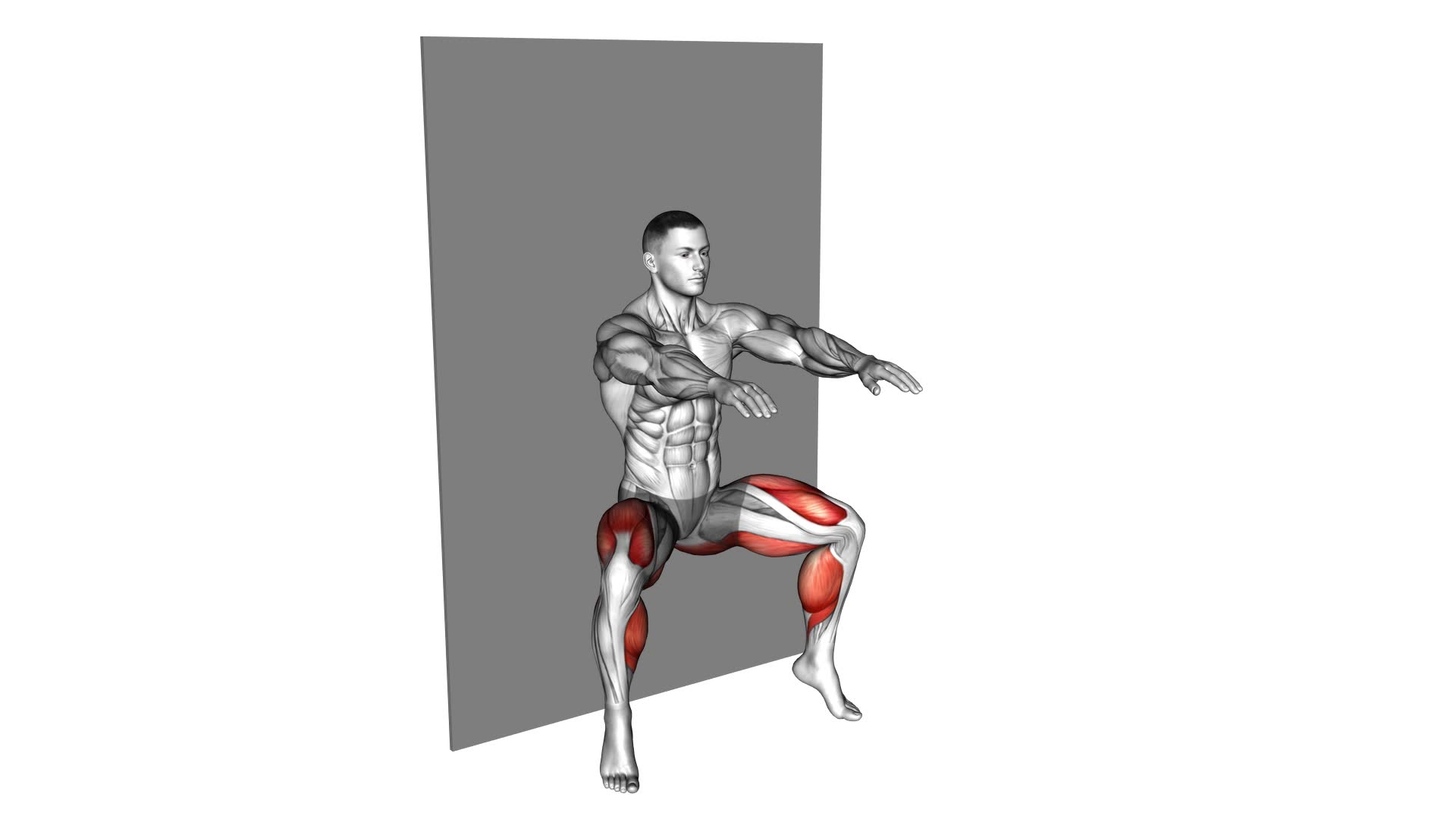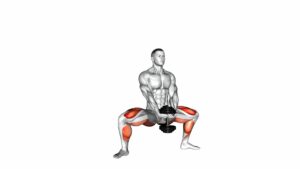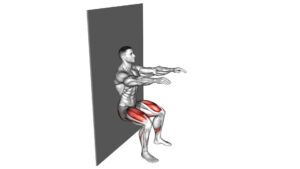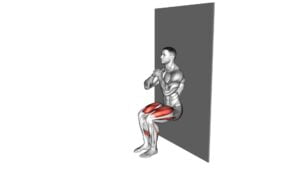Plyo Sit Squat (wall) – Video Exercise Guide & Tips

Looking to amp up your lower body workout? Check out this video exercise guide and tips for the Plyo Sit Squat (wall).
Watch This Exercise Video
In just a few minutes, you'll discover the benefits, proper form and technique, variations and progressions, common mistakes to avoid, and tips for maximizing your results.
Get ready to challenge yourself and take your fitness to the next level with this dynamic plyometric exercise. Let's get started!
Key Takeaways
- Plyo Sit Squat targets multiple muscle groups
- Plyo Sit Squat increases lower body strength
- Plyo Sit Squat improves agility and coordination
- Plyo Sit Squat enhances overall fitness level
Benefits of Plyo Sit Squat (wall)
You can experience numerous benefits from incorporating the Plyo Sit Squat (wall) into your workout routine. This exercise is designed to target multiple muscle groups and improve your overall fitness level.
One of the main benefits of the Plyo Sit Squat (wall) is increased strength. By performing this exercise regularly, you can build strength in your lower body, including your quadriceps, hamstrings, and glutes. This increased strength can improve your performance in other exercises and daily activities that require lower body strength.
Another benefit of the Plyo Sit Squat (wall) is improved agility. This exercise involves explosive movements and quick transitions, which can help enhance your agility and coordination. By incorporating the Plyo Sit Squat (wall) into your workout routine, you can become more agile and better able to move quickly and efficiently.
Incorporating the Plyo Sit Squat (wall) into your workout routine can provide you with increased strength and improved agility. These benefits can have a positive impact on your overall fitness level and performance in other exercises. Give it a try and start reaping the benefits today.
Proper Form and Technique
To perform the Plyo Sit Squat (wall) with proper form and technique, ensure a stable and balanced position against the wall. Start by standing with your back against the wall and your feet slightly wider than shoulder-width apart. Lower yourself into a squat position, keeping your knees aligned with your toes and your back against the wall. As you descend, imagine sitting back onto an imaginary chair. Push through your heels and explode upward, jumping as high as you can while extending your arms overhead. Land softly back into the squat position, absorbing the impact with your legs and maintaining stability.
It is important to maintain proper form and technique to prevent common injuries associated with this exercise. One common misconception is that leaning too far forward or allowing the knees to cave inward is acceptable. However, this can put excessive strain on the knees and increase the risk of injury. Another common mistake isn't engaging the core muscles, which can lead to lower back pain. It's crucial to brace your core throughout the movement to provide stability and protect your spine.
Variations and Progressions
Exploring different variations and progressions can enhance the intensity and challenge of the Plyo Sit Squat (wall) exercise. Here are some advanced modifications and safety precautions to consider:
- Weighted Sit Squat: Hold a dumbbell or kettlebell at your chest while performing the exercise to add resistance and increase muscle activation.
- Single-Leg Sit Squat: Elevate one foot off the ground and perform the sit squat using only one leg. This variation increases the demand on your lower body muscles and improves balance.
- Plyometric Sit Squat: Add an explosive jump at the end of each sit squat to incorporate plyometric training. This helps improve power and explosiveness in your lower body.
- Elevated Sit Squat: Place your heels on an elevated surface, such as a step or platform, to increase the range of motion and challenge your muscles further.
- Wall Sit Squat Hold: Instead of performing the sit squat dynamically, hold the squat position against the wall for an extended period. This is a great isometric exercise that targets your lower body muscles.
Remember to always prioritize safety when attempting advanced modifications. Start with lighter weights and gradually increase the load as you gain strength and confidence. Pay attention to your form and technique to prevent any potential injuries.
Common Mistakes to Avoid
What are some common mistakes to avoid when performing the Plyo Sit Squat (wall) exercise?
Proper technique is crucial for maximizing the effectiveness and safety of this exercise. Here are some common mistakes to watch out for:
- Not maintaining proper form: One of the most common mistakes is failing to maintain proper form throughout the exercise. Make sure to keep your feet shoulder-width apart and your knees aligned with your toes. Avoid leaning forward or rounding your back.
- Using momentum instead of muscle power: It's important to rely on your leg muscles to perform the Plyo Sit Squat (wall) exercise, rather than using momentum. Avoid bouncing off the wall or relying on a quick, jerky motion. Instead, focus on controlled movements and engaging your muscles.
- Not going deep enough: Another mistake isn't going deep enough into the squat position. To properly engage your leg muscles, aim to lower your hips until your thighs are parallel to the floor. Avoid shallow squats as they can limit the effectiveness of the exercise.
- Neglecting the landing: When jumping back up from the squat position, ensure that you land softly and with control. Avoid landing with locked knees or in an unbalanced position, as this can increase the risk of injury.
Tips for Maximizing Results
For optimal results, you should incorporate these tips into your Plyo Sit Squat (wall) exercise routine:
- Increase Intensity: To challenge yourself and maximize results, try increasing the speed of your movements or adding resistance by holding dumbbells or a medicine ball while performing the exercise. This will help to increase the workload on your muscles and promote strength and endurance gains.
- Modify for Beginners: If you're new to Plyo Sit Squats, start by performing the exercise without the plyometric jump. Focus on perfecting your form and gradually increase the depth and speed of your squats as you become more comfortable and confident.
- Engage Your Core: To optimize the effectiveness of this exercise, engage your core muscles throughout the movement. This won't only help to stabilize your spine but also enhance the activation of your abdominal muscles, providing a more intense workout.
- Maintain Proper Form: It's crucial to maintain proper form throughout the exercise to prevent injury and ensure that you're targeting the right muscles. Remember to keep your knees aligned with your toes, maintain a neutral spine, and engage your glutes and quads while performing the squats.
- Rest and Recovery: Give your muscles time to rest and recover between Plyo Sit Squat sessions. This allows for muscle repair and growth, which ultimately leads to better results. Aim for at least one day of rest between workouts to prevent overtraining.
Frequently Asked Questions
How Many Calories Does the Plyo Sit Squat (Wall) Exercise Burn?
The plyo sit squat (wall) exercise is a great way to burn calories and improve your overall fitness. By incorporating explosive movements and engaging multiple muscle groups, this exercise can help you increase your heart rate and boost your metabolism.
Additionally, there are various variations of the plyo sit squat (wall) that you can try to add variety to your workout routine. These variations can target different muscle groups and keep your workouts exciting and challenging.
Can Plyo Sit Squat (Wall) Help Improve My Vertical Jump?
Plyo sit squat (wall) is a beneficial exercise to improve your vertical jump. By incorporating explosive movements and utilizing the force generated from your legs, this exercise targets the muscles involved in jumping.
The plyometric nature of the exercise helps to enhance power and explosiveness. There are various variations of plyo sit squats that can be used to further challenge your muscles and progress your vertical jump.
Is Plyo Sit Squat (Wall) Suitable for Beginners?
Yes, the plyo sit squat (wall) exercise is suitable for beginners.
It's a great way to improve lower body strength and can be modified to match your fitness level.
By starting with a wall sit and gradually adding in the plyometric jump, you can build up your strength and power over time.
This exercise targets your legs, glutes, and core, helping you develop explosive strength for activities like jumping and running.
How Often Should I Incorporate Plyo Sit Squat (Wall) Into My Workout Routine?
To effectively incorporate plyo sit squats (wall) into your workout routine, consider your fitness level and goals. Start by modifying the exercise if you're a beginner, using a lower wall or bench for support. As you progress, increase the height and intensity.
Adding plyo sit squats to your HIIT workouts can boost lower body strength, power, and explosive movements. Aim to incorporate this exercise 2-3 times per week for optimal results.
Can Plyo Sit Squat (Wall) Help Strengthen My Core Muscles?
Plyo sit squat (wall) is a great exercise to strengthen your core muscles. By incorporating this exercise into your workout routine, you can improve your core stability and overall strength.
Athletes can benefit from plyo sit squat (wall) as it helps in enhancing power and explosiveness, which are important for sports performance.
Additionally, there are modifications available for this exercise to accommodate different fitness levels and goals.
Conclusion
To conclude, the plyo sit squat (wall) is a highly effective exercise for improving lower body strength and explosiveness.
By engaging the muscles in your legs and core, this exercise can help enhance your athletic performance and overall fitness level.
Remember to maintain proper form and technique, and gradually progress to more challenging variations.
Avoid common mistakes and follow the provided tips to maximize your results.
Incorporate this exercise into your routine for optimal benefits.

Author
Years ago, the spark of my life’s passion ignited in my mind the moment I stepped into the local gym for the first time. The inaugural bead of perspiration, the initial endeavor, the very first surge of endorphins, and a sense of pride that washed over me post-workout marked the beginning of my deep-seated interest in strength sports, fitness, and sports nutrition. This very curiosity blossomed rapidly into a profound fascination, propelling me to earn a Master’s degree in Physical Education from the Academy of Physical Education in Krakow, followed by a Sports Manager diploma from the Jagiellonian University. My journey of growth led me to gain more specialized qualifications, such as being a certified personal trainer with a focus on sports dietetics, a lifeguard, and an instructor for wellness and corrective gymnastics. Theoretical knowledge paired seamlessly with practical experience, reinforcing my belief that the transformation of individuals under my guidance was also a reflection of my personal growth. This belief holds true even today. Each day, I strive to push the boundaries and explore new realms. These realms gently elevate me to greater heights. The unique combination of passion for my field and the continuous quest for growth fuels my drive to break new ground.







